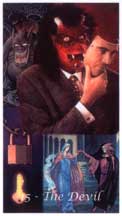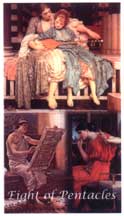The Odyssey Tarot Deck ~ Created by Jean Hutter
(Commentary by Arnell Ando)
With a Detailed Description of Jean's Deck Making Process
|

The Star
|
In this essay, I bubble with enthusiasm over a 78-card deck,
known as the Odyssey Tarot and share a few examples of favorite cards from this
lovely jewel. Afterwards I am honored to include the artist's detailed deck
making process shared in her own words.
I feel most fortunate to have recently acquired the strikingly beautiful and
powerful Odyssey Tarot, a collage deck created by the artist, Jean Hutter. Some
may be familiar with Jean's graphic, abstract or fine art which has been
exhibited at art shows, galleries, professional settings and can even be seen in
the popular HBO series
The Sopranos
however I know this gifted artist through her beautiful and deeply moving depiction of the Tarot.
Being a talented graphic artist, Jean Hutter has the distinct advantage of being
able to combine her collage imagery so colors and textures compliment each other
seamlessly, and when she chooses to mix alternative themes in a card, the edges
blend gently into new scenes that are pleasing to the eye. She has a natural
sense for placement and the rhythm of movement that keeps the mind intrigued.
Many cultures and eras are represented in this colorful deck in a flowing,
natural style. It is an enjoyable, meditative deck to read with, that also
explodes with life and emotion.
One of my favorites in this deck is the Star for it's languid beauty of dreamy
mermaids at sea in lovely hues of teal and turquoise, contrasted by a bright
burst of light from the star just beyond the mountains.
|

The Devil
|
Jean's Devil has dual roles, being both playful and frightening. A masked man at a masquerade
leads a woman seductively away. This could allude to the more sensual, erotic,
mischievous qualities of this card. While directly above this scene a hideous
Demon is revealed behind the mask of a handsome gentleman. A cartoonish Devil
behind him both confirms the demon's evil intentions while also bringing some
welcomed comic relief. I would think the locked chain and key dangling close-by
would indicate the choice of how this card plays out, being up to the seeker...
|

Nine of Pentacles
|
On a completely different note, the 9 of Pentacles is a serene portrayal of a
woman so at peace with her surroundings that a dove comes to rest on her
outstretched hand. This perfect depiction of the 9 of Pentacles is also a
lady-like nod in the general direction of our own Pixie Smith, (creator of the
Waite/Smith deck, published in Victorian era England). Equally lovely is the 3
of cups which shows three women setting off for an afternoon picnic, or nature
stroll. The mood is uplifting and the card is filled with greenery and growth.
Even the fair ladies dresses have colorful flowers. I feel these friends get
inspired in new directions whilst in each other's company.
|

Three of Cups
|
One of my favorite 'darker' cards in this deck is the 9 of Swords. The swords of
this suit cut the card in half. A close-up shot of a terrorized woman, gripped
with fear dominates the upper half of the card, while below, a caricature
of a man in his winter PJ’s stares at his pillow which has a gaping red mouth
full of sharp pointy teeth. Clearly he will have trouble sleeping this night as
is revealed by the nightmarish aura of this 9 of Swords, but the edge is taking
off this frightful scene in the style it is presented. It is both scary and
touching at the same time.
|

Nine of Swords
|
This is one of the gifts of Jean's deck, she is able to convey
emotion, and the impact of meaning in each card succinctly, while giving the
reader room to interpret from their own perspective, mood or the surrounding
cards in a reading. I don’t know if Jean Hutter plans to offer a book of
descriptions at some point, however while I would welcome the opportunity to
study her accumulated experiences and interpretations, I find this deck very
comfortable and easy to read. I have many more favorites but I'll just mention
one more; the 8 of Pentacles. By the way I tend to resist the energy of the
Pentacles as depicted in most decks (and as played out in my life) but Jean's
approach is a very harmonious and creative view of this suit, often
showing artists, dancers and musicians practicing their crafts and parents
passing on their innate gifts to their offspring such as in the 8 of Coins. I’m
charmed by female and male artists enjoying the act of creating, while above a
mother gently teaches her child how to play an ancient instrument.
|

Eight of Pentacles
|
Another thing I love about the Odyssey Tarot is that a suit often follows a thread or theme
over a succession of several cards, which confirms my feelings that the artist
thought deeply about the meanings of each card and how they play out in real
life.
Having created two 78-card Tarot decks of my own, I know how all consuming (in
every sense of the term) it can be to give oneself up to such an arduous goal.
Books, magazines, ads, greeting cards, photographs are scrutinized for any Tarot
merit or hidden ingredients. I've been guilty of murdering timeless books for
the sake of creating the card haunting my obsessed mind. Everything becomes
viewed through the prism of the Tarot and reality takes on a surreal collage
quality. Dreams are often cluttered with the symbolic code of Tarot as well.
While I created my decks by hand with piles of old art books, stick glue and
tiny razor sharp scissors, I wished I had an inkling of the knowledge and talent
that Jean Hutter possesses as an accomplished graphic artist. I have since
studied Photoshop in depth and am quite mesmerized by the freedom and endless
possibility it makes available to us, but I look to Jean Hutter's deck as a
perfectly orchestrated collage depicting various cultures, eras, and views
that blend effortlessly together. It is a captivating rendering of the Tarot.
An especially appealing quality of the Odyssey Tarot is the deck presentation
itself.
Jean has devised a technique of laminating the cards that makes it possible to
trim them clean to the edges (without need for the protective 1/4" lamination
border). They are sturdy yet flexible, lightweight and easy to shuffle. This
method would work well for anyone that wants to hand make a deck without illustrated backs
(this would not work as well with my decks which have imagery on their backsides that need to be precisely
centered by hand.) Jean's method of
deck making is not only beautiful but also a great time saver over my old-school,
6 step style. I have asked Jean Hutter to share her method for those of you interested
and she has generously accepted. So without further ado, here is the artist herself explaining her process...
The Making of the Odyssey Tarot Deck
~ by Jean Hutter
When I decided to make my own Tarot deck I started reading different articles
and looking for web sites with information about making a deck. I started
looking at magazines, clip art and art books for appropriate images. At this
point I was just “collecting”. Having a background in graphic art, I decided I
would do all the work in Photoshop rather than cutting and pasting by hand. This
is really a time saver because it is very easy to resize and cut up images on
the computer. I did a lot of scanning and tried to make a folder for different
types of images – Majors, Courts, Wands etc. and I also made a folder for
miscellaneous images that I just liked and thought might be useful. This was
also a time saver when it came time to do the actual work of making the cards –
it was easier to look for appropriate images in a folder rather than look
through everything.
My next step was deciding what size I wanted my cards to be, did I want a border
and what kind of lettering to use for the titles. I settled on a thin white
border and white lettering on the bottom of the card – the cards would be the
standard size. I started with the Majors, moved on to the Courts and finally the
Minors – for the Minors I did all the Aces, Twos, etc. – I found this easier
than doing the complete suit. As I said I used Photoshop to create the actual
cards. Once I completed the deck – I printed a master set on my inkjet printer.
I also made 2 backup copies of the deck on CD – one I keep in my house the other
at a friend’s house. Next I got laser copies made at a printer.
My next step was to assemble the deck. I did a lot of trial and error on this. I
wanted a deck that looked nice, had a good feel, was easy to shuffle and work
with but was also sturdy. I assemble one deck at a time and each deck has a
different backing. I run the laser copies through a Xyron machine that puts
permanent adhesive on the back - then I adhere the images to the desired
backing.
Next I do the lamination - I use a Xerox hot laminator and use 3mil pouches that
I get from www.oregonlam.com (they have good prices). I got the laminator from Staples for
$79 and I love it. What I like most about this laminator is that you can adjust
the temperature – this makes a big difference when using different weights and
types of lamination pouches.
Next I cut the cards to size – since the backing is put on with permanent
adhesive I can cut the cards right up to the edge – leaving no laminated border.
For the cutting I use a Fiskars trimmer that I bought at a craft store. The last
step is to round the corners – I bought a nice sturdy corner punch from Oregon
Lamination. It is quite a job to do a deck but I think the finished product is
well worth it. The deck has a card look and feel, but I think it will hold up
real well to a lot of use.
Jean Hutter
is an accomplished artist and creator of the incredible Odyssey Tarot deck.
View her art site here.
This handmade deck is no longer available, nor is the webpage showcasing the cards, alas. It sold briefly for $125.
I feel very fortunate to have obtained it from Jean and appreciate her sharing her creative process with us.




